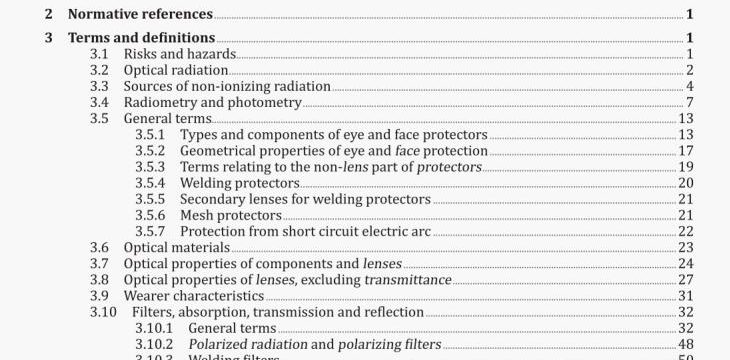Eye and face protection Vocabulary
AS 1337.0-2020 pdf download.Personal protective equipment Part 0 : Eye and face protection Vocabulary.
3.4.11
spectral luminous efficiency
V(A)
<for photopic vision, for a monochromatic radiation of wavelength, A> ratio of the radiant flux (3,iZ) at wavelength Am to that at wavelength A, such that both produce equally intense luminous sensations under specified photometric conditions and Am is chosen so that the maximum value of this ratio is equal to I
Note 1 to entry: Unit: 1 (dimensionless).
Note 2 to entry: The spectral luminous efficiency of the human eye depends on a number of factors, particularly the state of visual adaptation and the size and position of the source in the visual field. For this reason, it is possible to define a number of spectral luminous efficiency functions, for specific visual conditions.
Unless otherwise indicated, the values used for the spectral luminous efficiency In photopic vision are the values
agreed internationally in 1924 by the CIE (see Reference [29]), completed by interpolation and extrapolation
(ISO 23539:2005/CIE S 010:2004), and recommended by the International Committee of Weights and Measures
(CIPM) in 1972.
Note 3 to entry: CIE, considering the discrepancies between the average human spectral luminous efficiency and the V(A) function, adopted in 1990 (see CIE 86: 1990) the CIE 1988 modified 2° spectral luminous efficiency function for photopic vision, VM(A), and recommended it for applications in visual sciences.
Note 4 to entry: CIE, considering that the spectral luminous efficiency function of the human eye changes with visual angle, adopted in 2005 (see CIE 165:2005) the CIE 10° photopic photometric observer”, V10(A), to be used If the visual target has an angular subtense larger than 4° or Is seen off axis. This standard observer is not used in the assessment of personal protective equipment.
[SOURCE: CIE S 017:2011, 17-1222, modified — Note 1 to entry has been added to explain the dimensionless unit, CIE notes 1 to 3 have been renumbered as Notes 2 to 4, the original CIE notes 4 and 5 and references to scotopic vision have been deleted, and the last sentence in Note 4 to entry has been added .1
3.4.12
candela
unit of luminous intensity of a source
Note 1 to entry: SI base unit for photometry: the candela, Is the luminous intensity, In a given direction, of a source that emits monochromatic radiation of frequency 540 x 1012 lIz and that has a radiant intensity in that direction of 1/683 W/sr (16th General Conference of Weights and Measures, 1979).
Note 2 to entry: The candela is thus expressed as lumens ler steradian. cd = lm’sr1.
[SOURCE: CIE S 017:2011, 17.117, modified — a simpler definition has been made, the CIE definition has been moved to the Note ito entry, and the description of the unit has been placed in Note 2 to entry.]
3.4.13
solid angle
Ω
<of an area subtended at a point> area intercepted on a unit sphere, centred at the point, by a cone having the given area as its base and the point as its vertex
Note 1 to entry; If an imaginary sphere Is constructed with Its centre at the apex of the angle. the value, 11, of the solid angle is given by the area, A, enclosed by the angle on the surface of the sphere divided by the square of the sphere’s radius, r.
Note 2 to entry: Solid angles are expressed in steradians tsr. Note 3 to entry: See Figure 1.
[SOURCE: CIE S 017:2011, 17-1201, modified — the notes to entry have been added.]AS 1337.0-2020 pdf download.
Eye and face protection Vocabulary
